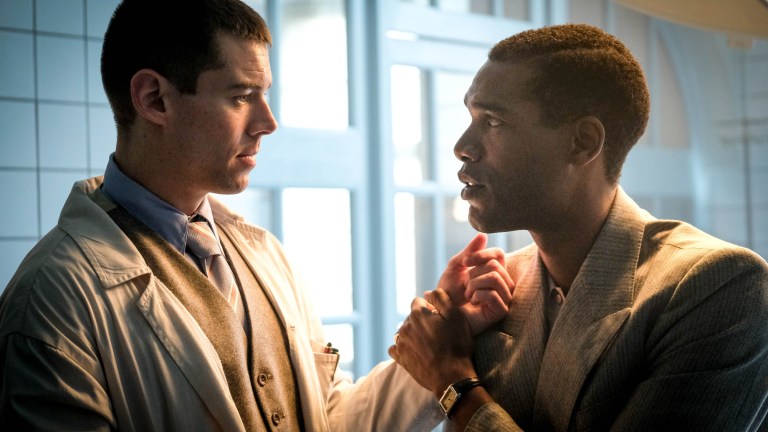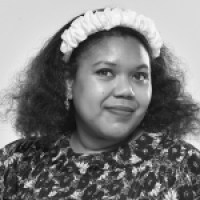How World On Fire Spotlights Previously Untold Queer History
World on Fire's Webster and Albert redefine queer identity in wartime dramas.

Note: Although this article does not contain World on Fire spoilers beyond Episode 4, the interview links contain spoilers for future episodes.
World on Fire‘s Webster O’Connor (Brian J. Smith) and Albert Fatou (Parker Sawyers) have a romantic relationship that transcends nationality and race, yet their very existence in 1940 Paris presents untold dangers. Some may have an idea of how their plot may end, but World On Fire ensures the audience can still hold onto hope through well-acted emotions and depictions of their lives in Paris.
Episode 1 introduces Webster as a doctor in the American hospital in Paris. His aunt Nancy Campbell (Helen Hunt) warns him the war is coming, but he thinks her line of work has made her overly cautious. When Webster goes to an underground jazz club to burn off the stress of work, he sees Albert. He’s instantly attracted to Albert, despite coming from and living in opposite worlds. According to a BBC interview with Smith, “Webster was brought up in Texas, which likely had a lot of intense racial undertones…however, in Paris and at Albert’s club he finds a place where he can be himself and live his dream.”
Albert is a popular Parisian saxophone player and bandleader. In an interview for the BBC, Sawyer frames him as “…a young Kanye West in a happening club, packed full of dancers, and he is in control of the party. Webster comes in and is just in awe of this guy who is cool, comfortable in his skin, French, and a charmer.” Music and the arts are Albert’s livelihood, which is worlds away from the sterile hospital hallways Webster spends his time in.
Albert is clearly the gender mirror to Connie’s (Yrsa Daley-Ward) story, but also her opposite in terms of military status and how they define their nationalities. This is important because, as a professional musician, war would likely end Albert’s career. Connie has a strong Manchester accent while Albert has a faint trace of a non-Parisian accent. His adamance in defining his nationality as French indicates he likely immigrated from a former colony. Before the war, many people from the colonies moved to Paris for improved educational and employment opportunities. In an era where various nationalist movements legally or socially stripped citizenship from naturalized citizens, Albert is defying these trends in his own way.
Webster and Albert’s budding romance in Episodes 2 and 3 takes a common period romance trope and redefines it. Just as Caroline Penvenen on Poldark uses a medical appointment excuse to flirt with Dr. Dwight Enys, Albert visits Webster at the hospital after an injury, however World on Fire breaks from other period dramas by normalizing queer expressions of affection. The camera doesn’t shy away from Webster and Albert in bed together or kissing. Although Albert and Webster have to distance themselves on a park bench, the show treats their relationship with just as much sympathy as Kasia (Zofia Wichłacz) and Harry (Jonah-Hauer King)’s short-lived marriage. The audience gets the sense Webster is falling in love for the first time and Albert is showing him how to undo all of the years of repressed desire.
Few previous period dramas depict the experiences of gay men during World War II. In an interview for the BBC, screenwriter Peter Bowker said: “We are hopefully now at a time where we can tell a story about two gay men living during the Second World War that is not sublimated into Brief Encounter.” Although Home Fires combines military and civilian queer experiences, thee queer characters featured are British women. Cabaret and Bent have theater and film adaptations that present the German gay experience in which Nazi party suppression was implemented several years before the war. Bowker’s careful research into the era proves that, just because these stories were not featured before, they have always been there, waiting to be told.
Albert’s story is also an opportunity to explore black identity outside of American or British history. The French also have a very long history with colonialism and slavery, but differences in government structure, culture, and religion altered the course of French colonialism. Black characters in period dramas are frequently framed through a distinctly American or British cultural lens. Although some may question Albert’s career choice as a trope, Paris between the wars was a refuge for entertainers such as Josephine Baker whose careers were stunted by legal segregation.
Episode 4 brings one aspect of the war directly to Webster and Albert. The hospital is already showing signs of Nazi influence. Although the Americans are officially neutral at this point in the war, Webster is making the professional choice to align himself with the anti-Nazi armies. The rules say he must turn away Jewish patients, but he ignores them. He still treats a pregnant Jewish woman and he supports a Jewish nurse who decides to stay and fight.
Towards the end of the episode, Albert finds a swastika painted with blood and a pig’s head outside his door. Albert realizes that his safe space in Paris is under attack while Webster still believes their future together is bright. Smith said: “Webster is still, for better or for worse, very good at maintaining those blinkers, at keeping any threat at bay, because that’s how he learned to survive.” The audience remembers through all of these scenes aunt Nancy’s counsel, but we see Webster hasn’t completely connected the dots.
Although some fans on social media have objected to World on Fire featuring Webster and Albert’s story, the message in the first four episodes is clear. Queer people lived during World War II and they had to navigate surviving not only homophobia in their own countries but also Nazi Germany’s legalized genocide. These critics must grapple with the reality that there is a direct correlation between modern intolerance and past legalized discrimination of queer people. The swastika may be only the beginning of what Webster and Albert face when those in power find out they are gay.
